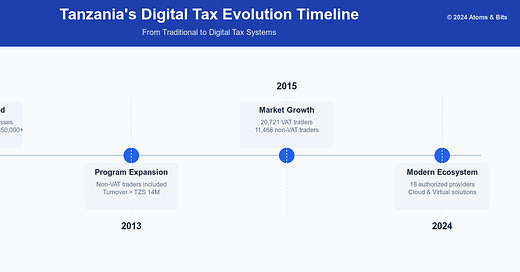Introduction
Tanzania's digital tax compliance journey began in 2010, when TRA first mandated Electronic Fiscal Devices (EFDs).
The initial rollout targeted VAT-registered businesses, requiring them to purchase physical machines costing upwards of TZS 350,000. By 2013, the program expanded to include non-VAT registered traders with annual turnover above TZS 14 million.
This transformed tax collection efficiency. Revenue increased from TZS 9.9 trillion in financial year (FY) 2014/15 to over double that amount (TZS 26.7 trillion) in FY 2023/24.
What's often overlooked is how this shift fundamentally changed Tanzania's entrepreneurial scene by widening the tax base and reducing evasion.
Before EFDs, tax compliance relied heavily on paper receipts and manual audits. The introduction of digital systems marked Tanzania's first large-scale push toward business automation.
Businesses must report income, generate receipts, file returns, and remit payments on time. Modern tools make compliance a real-time online responsibility instead of an accounting burden.
Today's Tax Technology Industry
As of January 2023, TRA had authorized 18 fiscal solution providers—a market that has evolved from simple receipt-printing machines to sophisticated cloud platforms. We have broken down this fintech sub-sector into three distinct segments.
Traditional Hardware Providers
Power Computers leads traditional EFD deployment with physical machines imported from China. Their systems emphasize reliability through dedicated hardware but require significant upfront investment.
Cloud-Native Solutions
Simplify VFD exemplifies the new generation of app/browser-based platforms. With setup costs of TZS 142,780 and annual fees of TZS 69,620, they've made invoicing more accessible for growing enterprises.
Hybrid Offerings
Companies like Radix, Zalongwa, and Web Corporation operate in both worlds. They offer both physical devices and virtual solutions, mostly for fuel stations and large enterprises. This flexibility comes at a premium, with setup fees typically exceeding TZS 500,000.
Types of TRA-approved Fiscal Devices
TRA recognizes five distinct categories of fiscal solutions, each designed for specific business needs and operating environments.
Electronic Tax Registers (ETRs) serve retail businesses issuing handwritten receipts. They provide basic sales tracking and tax calculations. Electronic Fiscal Printers (EFPs) connect to existing computerized retail systems, storing all transactions in secure memory. These suit businesses already using point-of-sale (POS) software.
Electronic Signature Devices (ESD) authenticate computer-generated receipts and invoices with unique digital stamps. This option works well if you prefer using your existing accounting systems.
Electronic Fiscal Pump Printers (EFPP) integrate directly with fuel dispensing systems at petrol stations, ensuring every sale is properly recorded and reported.
The newest category, Virtual Fiscal Devices (VFDs), eliminates physical hardware requirements entirely. It includes pure software solutions that run in web browsers and mobile apps.
Each device type must meet TRA's core requirements: tamper-proof revenue memory, automatic daily Z-reports, direct data transmission to TRA, and unique receipt identification. Physical devices must also provide 48-hour power backup and maintain five years of transaction history.
Getting Started with Virtual Compliance
Before implementing any VFD solution, businesses must complete several crucial steps. Below I have used Simplify’s onboarding process as an example.
Why? Installation costs USD 52.34, and the first annual subscription costs USD 25.52. At a total of TZS 212,400, it's cheaper than what other companies charge new customers.
Documentation Requirements
Valid TIN certificate
National ID verification
Formal request letter to TRA using their template
Regulatory Approval Process
Initial TRA application review (2-3 days)
Payment of registration fees
Customer visits local tax office for final verification
System activation approval
Technical Setup
Internet connectivity assessment
User access configuration
Login credentials sent via email
Staff training scheduling
Test transaction validation
You should maintain manual receipt books during the first week of implementation. This parallel system, while seemingly redundant, ensures smooth transition and maintains compliance during initial staff training and system optimization.
I believe that your preferred fiscal solution must be modern enough to work seamlessly with existing business tools.
Simplify, for instance, enables integration with third-party inventory and accounting software while providing EFD signatures on invoices. Its application programming interface (API) is utilized by reputable companies across various sectors, including transportation, oil and gas, tourism, and healthcare.
That service integration capability reduces double entry and reconciliation time. It’s a crucial factor for companies handling hundreds of daily transactions. For detailed information, email sales@simplify.co.tz or call +255 745 507 103 / 0658 507 103.
Regional Context
Tanzania's approach mirrors trends in developing economies. Kenya's iTax system and Rwanda's Electronic Billing Machines (EBMs) show similar evolution from hardware to cloud solutions. However, each country has unique requirements:
Rwanda mandates centralized billing for all businesses above RWF 20 million (TZS 40.73 million) annual turnover
Kenya allows mobile-first solutions integrated with M-PESA
Tanzania emphasizes real-time data transmission to TRA
Market Performance and Adoption
Data from the Tanzania Revenue Authority reveals interesting adoption patterns.
Of the 25,908 VAT-registered traders, 20,721 (~80%) had acquired EFDs by June 2015. 11,466 non-VAT traders acquired fiscal devices during Phase II implementation, primarily in sectors like spare parts, hardware, pharmacies, and hospitality.
This expansion indicates growing acceptance of digital compliance tools among smaller enterprises
Making the Choice
When evaluating fiscal solutions, businesses should consider:
Infrastructure reliability (especially internet connectivity)
Growth projections and scalability needs
Integration requirements with existing systems
Total cost of ownership, including maintenance
Staff technical capability
If you own or operate an urban enterprise with stable internet, virtual solutions—like Simplify VFD—provide clear advantages in cost and flexibility. Rural operations might still benefit from traditional EFDs' offline reliability.
Conclusion
Tanzania's shift to digital tax filing indicates modernization of our financial infrastructure.
Since mobile money transactions exceed TZS 12.6 trillion monthly (2023) and fintech adoption grows, cloud-based tax solutions become natural extensions of how Tanzanian businesses operate.
The next evolution will likely merge compliance, payments, and business intelligence into unified platforms accessible to enterprises of all sizes.








